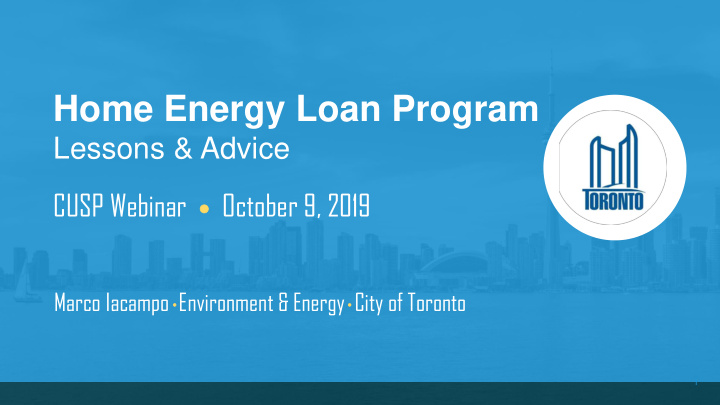



Home Energy Loan Program Lessons & Advice CUSP Webinar October 9, 2019 Marco Iacampo Environment & Energy City of Toronto 1
Toronto’s Climate Action Strategy 2050 8 0 % X GGHG reduction 2
Mind the 9 MT Gap 3
TransformTO Goals 4
Local Improvement Charges Regulation enables the assessment • of special charges on benefitting properties for energy and water improvements Exclusive to municipalities • Loan is not a personal debt, attached • to property, transfers at time of sale Repaid via surcharge on property tax • bill Priority lien status High-level of • security
Home Energy Loan Program Participation & Uptake to date Since 2014 Applications 944 Completed Projects 203 Average Loan Value $20,000 Total Capital Expenditure $4.5 million
Lessons Learned Key Considerations
1 One-window service adds value Lesson Learned 80% of participants would recommend HELP to family and friends • Simplified pathway to completing a home energy retrofit • Stacking of complementary incentives and grants • Promotes all available energy and water conservation, and more Key Consideration • Customer-focused program is critical • Streamline to avoid process disconnects/duplication • Compliance with local regulations may frustrate an ‘ideal’ administration 8
2 Continuous program enhancement Lesson Learned Regular updates to program offering is critical to address market needs Increased max loan amount, initial disbursement and eligible measures resulting in a doubling of applications Key Consideration • Regular dialogue with program stakeholders and participants to understand pain points and emerging needs • Build-in flexibility into program by-law, ideally without having to seek City Council resolution 9
3 Low volume of projects undertaken Lesson Learned 1 in 4 applicants complete a home energy retrofit and access financing Half of homeowners with a mortgage drop out • Mortgage lender consent, mandatory EnerGuide pre/post assessment, contract, invoice submittals are all required of a participant. Key Consideration • Greater volume can be achieved with less requirements • Understand the market segment you are trying to serve and tailor your marketing and outreach accordingly 10
4 High quality, deep retrofits completed Lesson Learned HELP enables deep, multi-measure retrofits that encouraged homeowners to do more, sooner • Average of 64 GJ of energy savings per project, $560 in energy savings HELP outperforms typical EnerGuide results (44GJ) • Longer term payback measures (e.g. windows) Key Consideration • 7-8 months to complete renovations • Offer options for matching payment term to asset useful life • Extend financing to also support non-energy improvements (i.e. demolition, environmental remediation) 11
5 EnerGuide Home Rating System Lesson Learned • Standardized home energy assessment works • Provides a robust M&V data set for results reporting • Support from NR Can (e.g. audits) is appreciated Key Consideration • Don’t reinvent the wheel ! • Homeowners find high value in pre/post assessment and consultation with energy advisor • De-risks capital deployed to energy efficiency improvements 12
6 Achieving a cost-neutral administration is tricky Lesson Learned ‘User - pay’ model is attractive to garnering support from senior management and City Council • Administrative charge (2% of capital) was insufficient in generating enough revenues to cover program costs Key Consideration • Unsure participants ‘sensitivity’ to higher pricing • Understand fixed and variable costs and set an appropriate administrative charge to recover those expenditures 13
7 Soup-to-nuts delivery model is labour intensive Lesson Learned All aspects of program delivery - marketing and promotions, applications processing, contracting, tax assessments - are managed by City staff • City staff across 5 Divisions have an administration role • City maintains control and oversight Key Consideration • Minimum role for a municipality involves passing property- specific by-laws to impose the local improvement charge and tax billings • Consider the role of a delivery agent and channel partners to manage elements of program implementation 14
8 Sustainable capital funding source Lesson Learned Utilized a $10 million reserve fund for initial funding tranche • long term solution that is scalable and flexible is needed to re-capitalize HELP Key Consideration • Green bond issuances, revolving funds, FCM’s Green Municipal Fund, infrastructure banks are potential sources of capital • Consider approaches that crowd-in private capital • Conscious of municipal debt limit and credit rating 15
9 Getting the marketing and promotions right Lesson Learned Community-based approaches are effective, but difficult to maintain ongoing momentum • City Councillors and gas utility most effective channels • Digital media more effective than traditional • Contractor engagement and training workshops Key Consideration • Modest budgets and lack of expertise • Leverage channel partners for promotions: contractors, utility companies, equipment manufacturers, community groups • Geo-target a neighbourhood primed for action (i.e. homes using oil for space heating). 16
10 Financing Alone is not a Silver Bullet Lesson Learned A low-interest, longer pay back loan is not a enough to compel action • A more supportive regulatory context is needed, with enabling strategies such as: Home energy reporting and disclosure, mandatory energy/ carbon Key Consideration intensity standards, carbon price on fossil fuels • What additional carrots and sticks can transform the market and drive scale-up? • Building energy literacy with homeowners is an important first step 17
Helpful Resources • LIC Primers and FAQs • Legal Opinion • Program Design Guidance • M&V Framework https://www.cleanairpartnership.org/projects/cheerio/
Thank You Merci Marco Iacampo Program Manager Environment & Energy City of Toronto Marco.Iacampo@toronto.ca 19
Recommend
More recommend